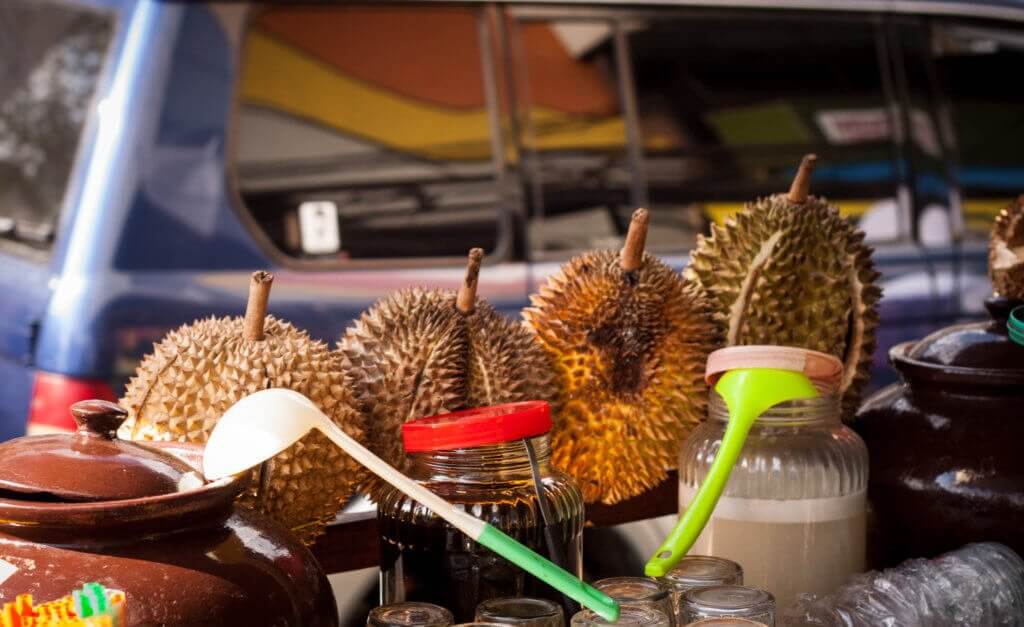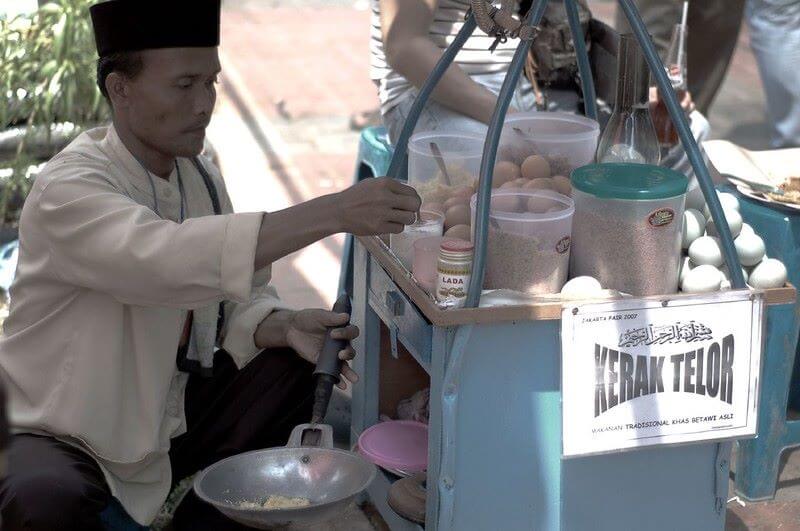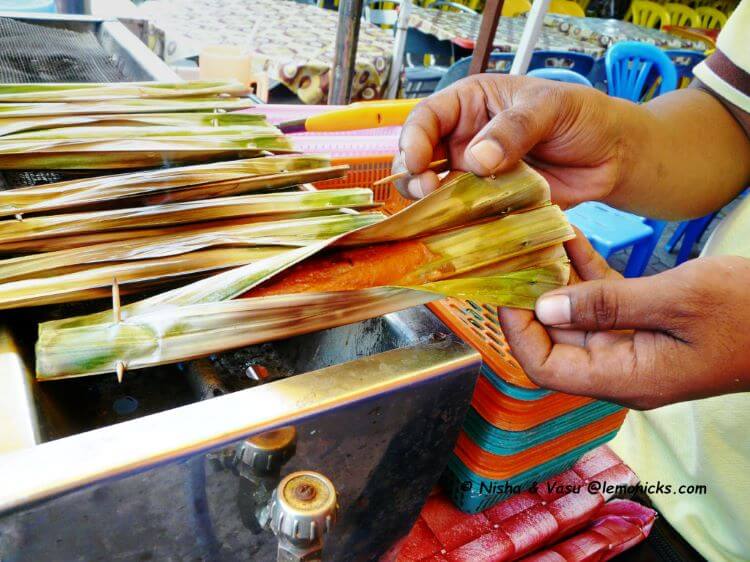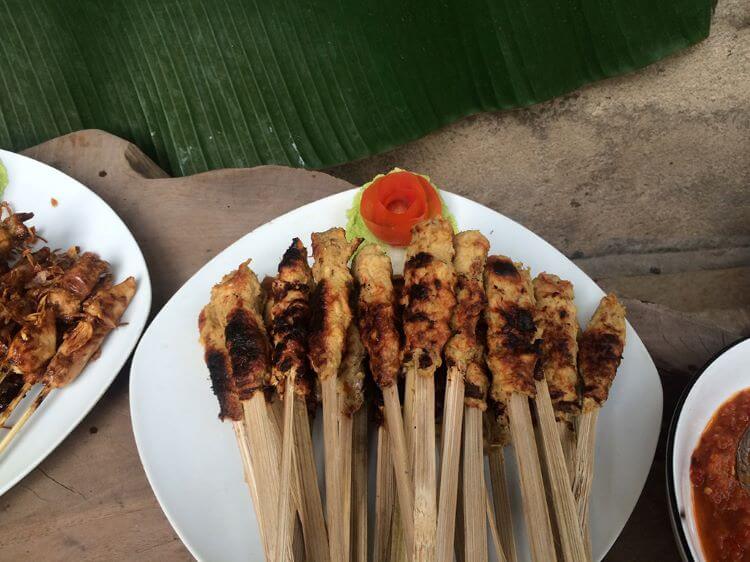Street vendors and food carts are common sites in Asian countries and the streets of Indonesia are no exception! Indonesian street food is known as kaki-lima which means “five feet.” This is the width of the pavement and it’s where Indonesian street food stalls sell their cheap and fresh foods.
Authentic Indonesian street food can be found in the heart of Jakarta in markets, the night market of small towns, warungs, food booths, and tiny food mobile carts (gerobak). You’ll also be assailed by street food vendors selling to cars gridlocked on Indonesia’s roads. They carry a long wooden pole with baskets or cabinets on either side, called pikulan which have been used in Indonesia to sell street food for at least 150 years!

The spices, ingredients, and types of dishes vary across the Indonesian archipelago’s diverse geography of 300 ethnicities and 17, 508 islands.
Apart from sweet dishes (kue), the lingering taste that signifies a satisfying meal is a hot spiciness.
The ingredients you’ll encounter in the mix of Indonesian, Chinese, and Dutch influences in Indonesian street food include:
- Nutmeg, clove, tamarind, turmeric, peanut, chili
- palm sugar, palm wine, sugar palm sap
- coconut and coconut milk
- shrimp paste, soy sauce
- bananas, durian
- pancakes, fritters, steamed buns
- tofu, tempeh, mung beans, bean sprouts, sweet potato, preserved vegetables
- chicken and fish (rarely pork)

The Sound of Indonesian Street Food
The everyday sounds of Southeast Asia are part of the rhythm of life that makes being in this part of the world so distinctive.
Street food hawkers need customers to eat their food when it is hot and fresh and they need customers to know when they have set up on their street.
This means that distinctive calls and drumming noises are made by hawkers when they enter an area. The four main sounds emitted by Indonesian street food sellers are:
- Bakso: Banging on a wooden slit drum called a kentongan
- Mie Ayam: Banging a wooden block
- Burbur Ayam: Banging on a soup bowl
- Satay: Calling out “tééé satééé”

11 Best Indonesian Street Food Dishes
Most Indonesian street food is fried (goreng), noodle-based dishes, soups, or fruit. Read on to discover the 11 best Indonesian Street Foods to try next time you’re hungry in Indonesia!
Soto Betawi

Soto means Soup and has spread throughout Indonesia from Java. It comes in almost every variety you can imagine.
The base of the soup is a broth and then meat and vegetables are added. Like westerners craving chicken soup when they are ill or needing comfort, soto ayam, is the Indonesian equivalent.
Soto Betawi most likely has been influenced by South Asian cuisine because it uses ghee. Betawi means goat and it’s been suggested that this was once a soup that was made when food was difficult or expensive.
Cultural historians believe it may have originally been made using goat (tangkar) bones, Soto Betawi has come to mean “meat soup” and is also known as Soto Tangkar.
Mie Goreng

Mie Goreng is a dish popular with Indonesians and tourists alike. It translates to “fried noodles” and can be viewed as the noodle alternative to Nasi Goreng, (“Goreng” meaning fried).
It is a simple and flavourful dish made up of noodles, garlic, onions, shallots, cabbage, tomatoes, egg, and other vegetables.
Seafood and meat, particularly chicken and beef, make popular additions to this otherwise vegetarian dish. Depending on where you are located in the country, the ingredients available to add to the dish may vary.
The noodles in Mie Goreng often come from instant noodle packages. This makes it an extremely affordable dish to prepare on your own, to buy in the streets, or to order at a restaurant.
You can find Mie Goreng all over the country but it is especially popular in Java.
Mie Goreng is thought to have been introduced to the country by Chinese immigrants. You can also find variations of it in Malaysia, Singapore, and other Asian countries.
We would recommend Mie Goreng to anyone looking for a quick and delicious dish in Indonesia. It is highly customizable and can be made spicy or mild. Eating is a great way to experience local Indonesian culture through your stomach.
by Oksana and Max at drinkteatravel.com
Nasi Goreng

Nasi Goreng may be related to the ubiquitous Chinese Fried Rice as it is stir-fried rice with other ingredients, but the Indonesian version is spicier and bolder than this take-out staple. The Malaysians use a sweet soy sauce called Kecap Manis which is a sweeter deeper flavor than regular soy sauce with its added palm sugar and spices. Topping the dish are crispy fried shallots and it is served with tasty crackers known as krupuk.
Nasi Goreng can be found on virtually every food stall in Indonesia and has become known as Indonesia’s national dish.
Street food vendors serve Nasi Goreng with a fried egg on top known as Nasi Goreng Istimewa which is heaven on a plate.
Nasi Goreng is a simple way to quickly fry a variety of vegetables with meat, tofu, or prawns with day-old cooked rice to provide a quick substantial meal.
Brought to Indonesia by Chinese immigrants between the 10th and 15th centuries, the distinctive Chinese culture and food were adapted to include fresh local ingredients and seasonings, creating a micro-cuisine that still retains its cultural roots.
Thanks to the Dutch East India Company you will find Nasi Goreng almost a staple dish in the Netherlands, just not quite a staple as on the streets of Indonesia!
by Faith from theworldskitchens.com
Other Types of Goreng


Kerak Telor

Meaning “egg crust,” Kerak Telor is a spicy omelet. There are a set of staple ingredients to this dish:
- egg (usually duck egg)
- rice (glutinous)
- spices
- fried shallots
- fried shredded coconut
- dried shrimp
And that’s it! Simple, made fresh to order. It was once a dish that made sticky rice more glamorous and was served to colonial officials and the Betawi ethnic group of Jakarta.
It has become the must-try dish that Indonesians look forward to eating at the annual Jakarta Fair.
But as an everyday snack food, it is a popular mobile food stall staple because it only requires a charcoal fire and a wok!
Gado Gado

From my 6 weeks traveling through Indonesia, I took home three main ingredients of the local cuisine, which I simply loved: peanut sauce, vegetables, and tempeh (a tofu-style but firm product of fermented soybeans). Luckily, all of these are united in one of Indonesia’s national dishes: Gado-Gado.
Gado-Gado is a nationwide available dish that is famous for its thick and tasty peanut sauce, which usually consists of fried peanuts, palm sugar, chilies, fish paste or garlic, and lime or tamarind juice, all blended together. This sauce is to-die-for and gets served with plenty of blanched fresh vegetables and rice.
While the traditional recipe also calls for tofu or tempeh, you find many places selling it just as a vegetable Gado-Gado. It usually gets served with rice, typical Indonesian crackers, and hard-boiled eggs on the side.
While Gado-Gado is not as commonly available as Nasi Goreng or Saté, you can find it in every kind of eatery: local street stalls, typical warungs, or Indonesian restaurants. In Jakarta, there are even Gado-Gado fast-food chains.
Gado-Gado has its origin in West Java. Nowadays the word is also used in the Indonesian language as “mixed up”. It refers to the mix of vegetables used for this national dish as well as mixing of the peanut sauce into the vegetables.
If you travel to Indonesia, make sure to try a few Gado-Gado and ask for your favorite version with tempeh, tofu, or only vegetables. But be careful, you might get addicted to the sauce!
by Chris at Punta Cana Travel Blog
Bakso

Bakso is the one street food that many local Indonesians can’t live without. It is an Indonesian meatball soup, whose name is originated from the Hokkien dialect and which means “fluffy meat”. The history can be traced from the Ming Dynasty back in the 14th century: the Hokkien Chinese who migrated centuries ago to Java introduced it to the locals.
Today Bakso has many variants that are influenced by the local taste. Many cities and places in Indonesia have different styles of Bakso. Bakso Solo and Bakso Malang are the most popular ones among many, particularly in Java.
Bakso Solo is mostly served with noodles and rice vermicelli in a mixture of soup and beef broth. On the other hand, Bakso Malang is usually served with tofu and fried dumplings.
Every region has its own way of enjoying Bakso.
Originally from Bandung in West Java, I have become used to eating Bakso with krupuk – Indonesian deep-fried crackers. However, in the Central and Eastern parts of Java, it’s quite common to also add lontong -Indonesian rice cake – to Bakso.
While it is essentially street food, you can now easily find Bakso anywhere, from the cart on the street to even the most elegant restaurants.
Recently, new fillings such as cheese and jalapeno complement the modern Indonesian love of spices.
by Marya Sutimi at The Beau Traveler
Ikan Bakar

If you eat non-vegetarian food, the Indonesian dish called Ikan Bakar should be on your list. The grilled-barbecued fish is considered a classic dish of Indonesian cuisine.
Fish of your choice is marinated with the spices turmeric and coriander and a sweet soy sauce before being grilled.
The most traditional way to cook Ikan Bakar is to grill the fish by wrapping it in a banana leaf over charcoal. Other methods include frying and boiling. The fish is normally served with rice, sambal, and fresh vegetables such as cabbage, tomato, lettuce, and cucumber.
Since Indonesia is an archipelagic nation, there is no dearth of fish varieties, and hence, Ikan Bakar is very popular in Indonesia. The country also produces many spices, which vary from region to region.
Even the preparation and taste of Ikan Bakar vary from one region to another such as Sundanese, Balinese, Sulawesi, and Malaku.
Ikan Bakar is enjoyed mostly on a beach with family and friends and is also included in the culinary itinerary during a visit to popular Indonesian destinations.
The best places to visit in Jakarta to eat Ikan Bakar include restaurants such as Pondok Ikan Bakar Ujung Pandang, Jakarta, Ikan Bakar Cianjur, and Gama Ikan Bakar & Seafood TMII.
by Nisha and Vasu at lemonicks.com
Babi Guling

One of the tastiest Indonesian foods is Babi Guling, both a dish and the process of roasting a whole hog, often for a party or family celebration in Indonesian culture. Events that warrant a Babi Guling feast include weddings, funerals, and a baby’s three-month birthday. The dish is most popular in Bali, an island with a Hindu majority, unlike some Muslim islands where many people don’t eat pork.
Nowadays, it’s a popular dish eaten at modest street food restaurants around the island of Bali.
The most popular warung in Ubud to serve Babi Guling is Babi Guling Ibu Oka, put on the map when Anthony Bourdain declared it the best roast pork he had ever eaten.
When marinated with coconut milk and lemongrass and served with crispy skin, who could blame him?
A quality Babi Guling is served with fluffy rice and basa gede, a mix of spices that include chili, coriander, and peppercorn. The meat is important but the spice mix also has to be just right!
To try the dish in a less touristic setting, visit Babi Guling Ibu Oka 2 located at Jalan Raya Mas, a 40-minute walk or short drive from central Ubud.
You’ll get the same delicious Babi Guling but without the queues.
by Rose at Where Goes Rose
Tempeh Satay

Satay is usually described as grilled meat served on skewers with peanut sauce. But not all satay is made with meat; tempeh satay is also quite popular in Java, where it originated. Like tofu, tempeh is a plant-based protein dish made from soybeans. There are some key differences between the two, though. Tempeh is fermented, which gives it more fiber, vitamins, and protein, and it also has a much firmer texture than tofu.
There are many different ways to prepare tempeh, but one of the most popular when it comes to street food is Tempeh Satay.
This dish originated in Surakarta, a city in Central Java that lies along the Solo River. In fact, the city itself is commonly referred to as “Solo”.
The type of tempeh used to make this dish is tempeh gembus, which is a soft and fluffy form of tempeh that’s made from soy pulp — the dregs left over after making tofu or soy milk.
Tempeh is a more affordable protein source than animal flesh, and tempeh gembus costs even less than other types of tempeh.
This is why, in the local Javanese language, tempeh satay is called “sate kere”, which literally means “poor man’s satay”.
It’s a great option for budget travelers, and also for vegetarian and vegan travelers in Southeast Asia, or anyone looking to cut down their meat intake. It’s commonly sold by itinerant satay vendors and by makeshift tent restaurants.
by Wendy at thenomadicvegan.com
Satay Lilit

Imagine a couple of mouthfuls of smoky aromatic fish and prawns blended with coconut, chili, and lemongrass and subtle hints of garlic and ginger and you are getting close to the taste of sate lilit.
Sates are usually marinated meat wrapped around sticks and grilled over charcoal. In Bali, if you ask for Sate Lilit you will get sticks blended fish on sticks.
As Bali is a small island, nowhere is more than a few hours from the coast, so freshly caught fish is easy to come by. Fishermen go out at night to catch the fish ready for the early morning markets.
Most warungs – small family-run restaurants – or roadside street food stalls serve Sate Lilit with accompaniments like sambal matah, a spicy lemongrass sauce.
It is one of the recipes that is handed down in Balinese families and can be subtly different depending on where you go.
Sate Lilit is best eaten fresh from the grill, sometimes served on sticks, but also on lemongrass sticks which gives an extra citrus taste.
As the fish is wrapped around the sticks it is turned giving the sate a ridged texture. The sticks have a couple of bites-worth on each one, so normally you get four or five at a time.
by Larch at thesilvernomad.co.uk
Rujak

Rujak (or called Rojak in Malaysia) is a common Indonesian traditional salad. While the recipes vary from place to place, the main ingredients of Rujak are usually fruit and vegetables like cucumber, pineapple, and watermelon. The dressing, it’s a mix of chili peppers, plum sugar, and peanuts. As a result, the dish has a refreshing and tangy sweet-and-hot flavor that compliments the fruit nicely.
Why is it popular in Indonesia? This is, in fact, an old dish in Java with a long history, and the locals are very attached to the dish. Rujak can be found widely in Indonesia, from local markets to upscale restaurants.
Yogyakarta is a major travel hub in Java because of its proximity to the two national monuments: Borobudur and Prambanan.
The city has a good choice of eateries and food markets along Malioboro and Prawirotaman where you will find Rujak on the menu. Madam Tan Resto is a popular local restaurant and it’s located opposite the famous Phoenix Hotel in Yogyakarta.
It has vintage décor and a comfortable setting – it has a nice dish of Rujak along with other authentic Indonesian dishes.
by Kenny at Knycx Journeying
